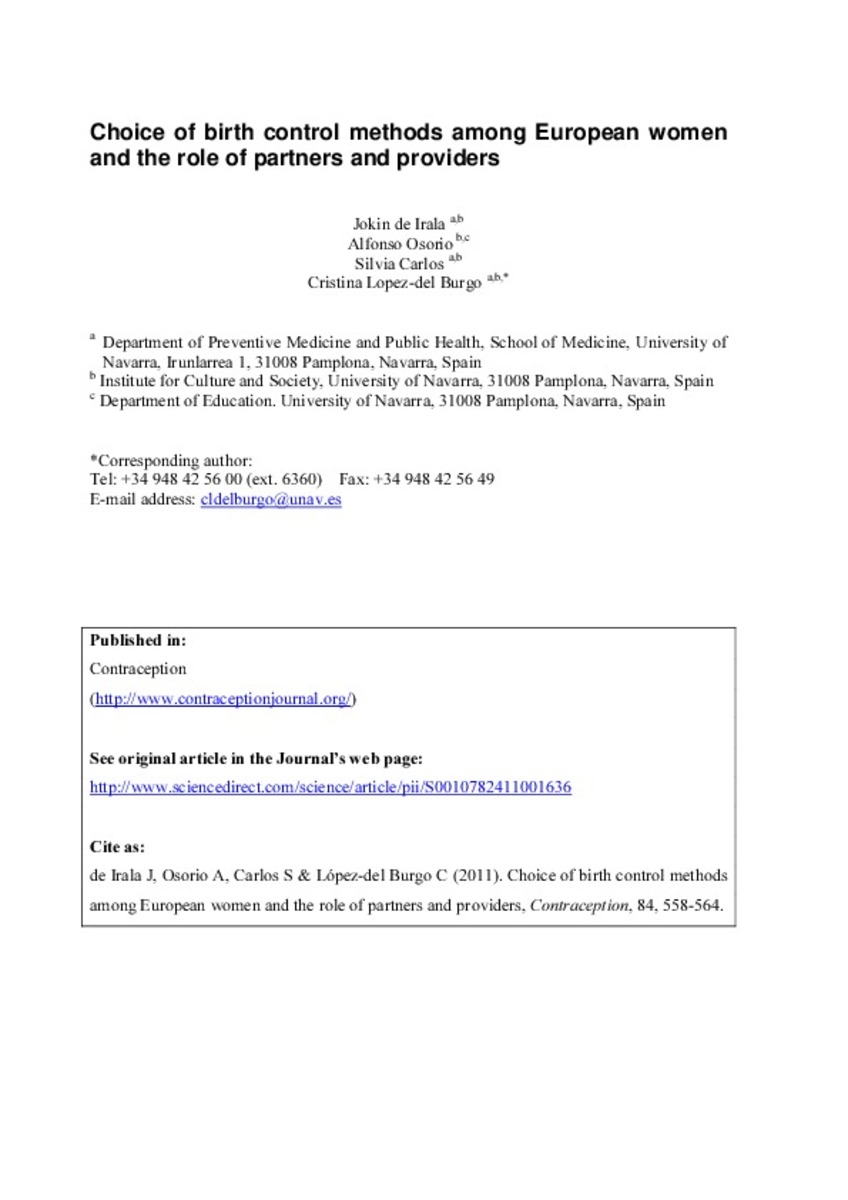Full metadata record
| DC Field | Value | Language |
|---|---|---|
| dc.creator | Lopez-del-Burgo, C. (Cristina) | - |
| dc.creator | Carlos-Chillerón, S. (Silvia) | - |
| dc.creator | Osorio, A. (Alfonso) | - |
| dc.creator | Irala, J. (Jokin) de | - |
| dc.date.accessioned | 2011-09-28T15:21:41Z | - |
| dc.date.available | 2011-09-28T15:21:41Z | - |
| dc.date.issued | 2011-12 | - |
| dc.identifier.citation | de Irala J, Osorio A, Carlos S & López-del Burgo C (2011). Choice of birth control methods among European women and the role of partners and providers. Contraception, 84, pp. 558-564. | es_ES |
| dc.identifier.issn | 0010-7824 | - |
| dc.identifier.uri | https://hdl.handle.net/10171/19110 | - |
| dc.description.abstract | Background: The choice of a birth control method is influenced by socio-cultural and personal factors. We explored the perceived influences in women’s choice of a birth control method in five European countries (Germany, France, the U.K., Romania and Sweden), where contraception is widely used. Study design: Cross-sectional study of 1137 randomly selected women, aged 18-49 years. An anonymous, 31-item questionnaire related to birth control methods was used. Logistic regression was used to identify variables associated with partner participation in choice of a contraceptive. Results: Oral contraceptives were mainly used in Germany (54.3%), France (50.5%) and Sweden (34.6%) and condoms in the UK (29.6%) and Romania (22.9%). Sweden showed the highest use of intrauterine devices (19%). Romania had the lowest use of contraception. Oral contraceptives and intrauterine devices use were frequently suggested by providers instead of by women. Choosing the method with the partner was associated with age (OR=0.97, 95%CI 0.94-0.99), university graduate (OR=1.59, 95%CI 1.01-2.29), married (OR=1.52, 95%CI 1.01-2.29) and with using a method that requires partner’s cooperation (OR=8.18, 95%CI 5.46-12.27). Conclusions: Hormonal contraceptives and intrauterine devices are commonly recommended by providers rather than requested by women. Partner preferences are taken into account when his cooperation in the use of the method is needed. As fertility care is a male and female issue, there is still more room for actively involving both women and men in choice of a birth control method. | es_ES |
| dc.language.iso | eng | es_ES |
| dc.rights | info:eu-repo/semantics/openAccess | es_ES |
| dc.subject | Informed choice | es_ES |
| dc.subject | Intrauterine devices | es_ES |
| dc.subject | Oral contraceptives | es_ES |
| dc.subject | Condoms | es_ES |
| dc.subject | Birth control methods | es_ES |
| dc.title | Choice of birth control methods among European women and the role of partners and providers | es_ES |
| dc.type | info:eu-repo/semantics/article | es_ES |
| dc.relation.publisherversion | http://www.sciencedirect.com/science/article/pii/S0010782411001636 | es_ES |
Files in This Item:
Statistics and impact
Items in Dadun are protected by copyright, with all rights reserved, unless otherwise indicated.






